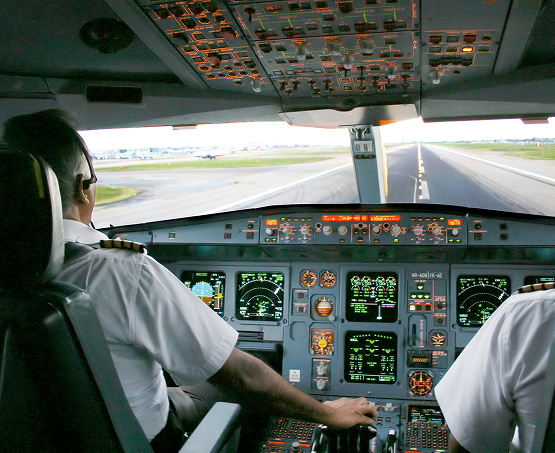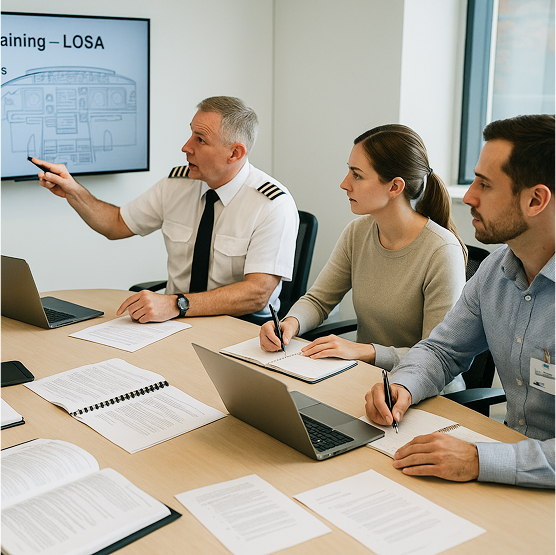Our team has extensive experience in the management and conduct of Line Operational Safety Audits. We have also been deeply involved in the analysis of LOSA observer reports to discover trends, uncover weaknesses, highlight strengths, and recommend targets for improvement.
Benefits
Engage with your crews.
Unbiased, anonymous, and non-judgemental perspective on operations
Understand and address vulnerabilities in operations.
Thorough understanding of operations, accompanied by recommendations for systemic safety improvements.
Understand positive performance.
Understand positive crew strategies and procedural workarounds.
Quantify LOSA data in your SMS.
Assess and prioritize the risks associated with hazards identified through our focused methodology.
Understand your threat environment.
Make sense of day-to-day challenges from
Involve your pilots actively in the safety change process.
Pilots have a critical part to play in the safety change process. Visibility of results will inevitably lead to some changes before any action plan is created.
Compare LOSA data with other sources.
The findings from LOSA can be compared and provide context to Flight Data Monitoring (FDM) and other relevant data sources.
Establish relevant data to support training.
LOSA data has consistently proven to be the most valuable resource for designing training programs.

Observers
- Observers play a pivotal role in LOSA, being carefully selected, trained, and entrusted with confidentiality and anonymity to obtain an accurate portrayal of normal operations. We invest significant effort in ensuring observers have a comprehensive understanding of the observation process, our narrative and coding tools, narrative generation, and safety aspects related to the observer’s intervention.
- As part of the training, the trainee observers undertake several observations in order for us to make a thorough review of their results and provide any necessary coaching. This step contributes substantially to the quality of the LOSA data.
- Observations capture a detailed narrative of the flight, prior to coding of TEM and related behaviors. Narratives are cross-referenced with technical and operations manuals where necessary.
- Observers are actively encouraged, supported, and coached throughout the narrative writing and review stages. Our approach allows ample time for reflection on observation notes, facilitating the preparation of comprehensive and in-depth assessments of the various factors influencing the actions of the flight crew.
Reporting
Focus on Vulnerabilities.
The report centers on identifying vulnerabilities in flight operations and providing actionable recommendations to strengthen policies, procedures, and practices as needed. It also highlights positive behaviors that go beyond procedural compliance and contribute to safety and efficiency.
Achievable Recommendations:
The recommendations are based on actual events observed during the LOSA process. However, the experience and expertise of the team allow them to identify potential weaknesses or vulnerabilities beyond the observed data.
Suggesting Review Areas:
In cases where there is insufficient information to support a clear recommendation, the report suggests specific areas for further review to either support or rule out potential vulnerabilities.
Recognizing Areas of Excellence:
The reporting protocols emphasize the importance of identifying and commending areas of excellence and best practices.
Collaboration:
The team works closely with various departments to validate the analysis and help them understand the report’s findings and recommendations. They support the implementation of changes where necessary.
Ongoing Approach:
The LOSA process is not just about generating a report. It extends to what actions the airline takes in response to the findings and how it promotes and recognizes its successes. This ongoing approach is seen as the true measure of a successful LOSA.
Overall, the LOSA process focuses on continuous improvement and aims to create a safer and more efficient flight operation by addressing vulnerabilities, encouraging best practices, and fostering a culture of safety.
To effectively assess the data gathered during LOSA, an analytic approach is essential. The TEM framework serves as the initial level of analysis, which is further supported by the Evidence-Based Training (EBT) competency approach. This combination enables a comprehensive view of the data through two complementary perspectives.
Jump-seat observations during normal operations
LOSA observations are limited to regularly scheduled flights. Line checks, LiFUS or other training flights not observed.
Voluntary crew participation
Maintaining the integrity of LOSA is extremely important for success.
Joint management /pilot group endorsement
Engagement of all stakeholders will maximize the benefits of LOSA.
Secure data collection repository
All data is encrypted and stored without reference to any names or flight numbers. This preserves the integrity of the program.
Data-derived targets for improvement
The output LOSA is the data-derived targets for enhancement based on vulnerabilities identified.
Anonymous, confidential, and non-punitive
Success in LOSA requires the support of management and pilots.
Trusted and trained peer (line pilot) observers
Observers that are respected and trusted to ensure acceptance of LOSA.
Systematic observation tools
The LOSA is based on a capture of the story of the flight, coded with TEM and the positive and negative influence of competencies observed during the flight.
Data verification
For a meaningful and objective analysis, data quality is paramount, and this is part of an ongoing process with observers and management pilots.
Feedback of results to line pilots
The first step in safety change is information which will drive some self-correction. As key stakeholders in the process pilots should be provided with relevant information.
Observers
Observers are the key actors in LOSA.

They are selected and trained and trusted. Anonymity and confidentiality provide a true picture of normal operations. We spend time equipping the observers with a thorough understanding of the observation process. This includes the basics of participant observation, the use of our own narrative and coding tools, the narrative generation process and key safety issues surrounding intervention by the observer.
As part of the training, we recommend that the trainee observers undertake several observations for us to make a thorough review of the results and to discuss any issues revealed during. This step contributes substantially. to the standardization and quality of the LOSA.
The emphasis of observations is towards capturing a full narrative of the flight prior to undertaking any coding of management and capture of behaviours. Narratives are referenced to aircraft operating manuals, company procedures, documents and associated training and assessment programs.
Observers are encouraged, supported, and coached through the narrative writing and review process. Our process allows for the time it takes to reflect on the notes taken during their observation and prepare a more detailed and extensive review of the various factors that influenced the crew’s actions.
Data Analysis
The analysis we undertake is based on these multiple sources of evidence and does not rely on the observations alone. To support a recommendation, we establish a clear chain of evidence and confirm our understanding with key members of your own organisation.

The Salient model employs an explanatory or causal case study approach.
From a research perspective, the question we are exploring is “how flight crew manage threat and error during normal flight operations”. It is important to be very clear that the unit of analysis in all observations is a flight. Case studies, like experiments, are generalisable to theoretical propositions and not to populations. It is not correct to simply view a case study as representing a “sample”. The case study approach aims to expand and generalise theories (analytic generalisations) and not to extrapolate possibilities (statistical generalisations).
The distinctive need for case study research arises out of the desire to understand complex social phenomena. This approach focuses on answering the how and the why, it does not require control of any events and it does focus on what is happening now or in those contemporary events. In other words, you would want to do case study research because you want to understand the real-world and assume that such an understanding is likely to involve important contextual conditions.
One contrast between the Salient method and a conventional LOSA approach is that we not only offer valuable guidance but also actively support the organization in implementing necessary changes.

